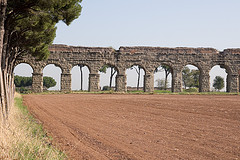 Most human societies have some kind of hierarchy, which means some folks have more of something — power, money, time — than others. And mutually beneficial cultural artifacts like aqueducts require cooperation and coordination. Yet at least in the short term, there is no advantage to the giver in yielding resources to another. This raises the question — how did the first hierarchies form? This research proposes using a mathematical model to explore that question. Under the conditions of the simulation, hierarchical societies were more successful at generating the resources their people needed. That means those societies grew faster and spread wider. More interestingly, it meant that even the folks at the bottom of the hierarchy were better off being part of those groups than in the groups where everyone is equal.
Most human societies have some kind of hierarchy, which means some folks have more of something — power, money, time — than others. And mutually beneficial cultural artifacts like aqueducts require cooperation and coordination. Yet at least in the short term, there is no advantage to the giver in yielding resources to another. This raises the question — how did the first hierarchies form? This research proposes using a mathematical model to explore that question. Under the conditions of the simulation, hierarchical societies were more successful at generating the resources their people needed. That means those societies grew faster and spread wider. More interestingly, it meant that even the folks at the bottom of the hierarchy were better off being part of those groups than in the groups where everyone is equal.
- Is this an extension of thermodynamics — that gradients and heterogeneous distributions are necessary to get things done?
- How would a servant leader dynamic compare in such a simulation?
- Does the model, and even the question about the formation of hierarchies itself, implicitly assume that hierarchies are “unnatural” in some sense? Do the natural hierarchies of family groups offer an alternative explanation for the seeding of hierarchical societies?
- Is it possible to use simulations to identify the kinds of hierarchies which best take care of their least advantaged members?
Photo by Ken Schwarz (cc)
Andy has worn many hats in his life. He knows this is a dreadfully clichéd notion, but since it is also literally true he uses it anyway. Among his current metaphorical hats: husband of one wife, father of two teenagers, reader of science fiction and science fact, enthusiast of contemporary symphonic music, and chief science officer. Previous metaphorical hats include: comp bio postdoc, molecular biology grad student, InterVarsity chapter president (that one came with a literal hat), music store clerk, house painter, and mosquito trapper. Among his more unique literal hats: British bobby, captain’s hats (of varying levels of authenticity) of several specific vessels, a deerstalker from 221B Baker St, and a railroad engineer’s cap. His monthly Science in Review is drawn from his weekly Science Corner posts — Wednesdays, 8am (Eastern) on the Emerging Scholars Network Blog. His book Faith across the Multiverse is available from Hendrickson.

Leave a Reply